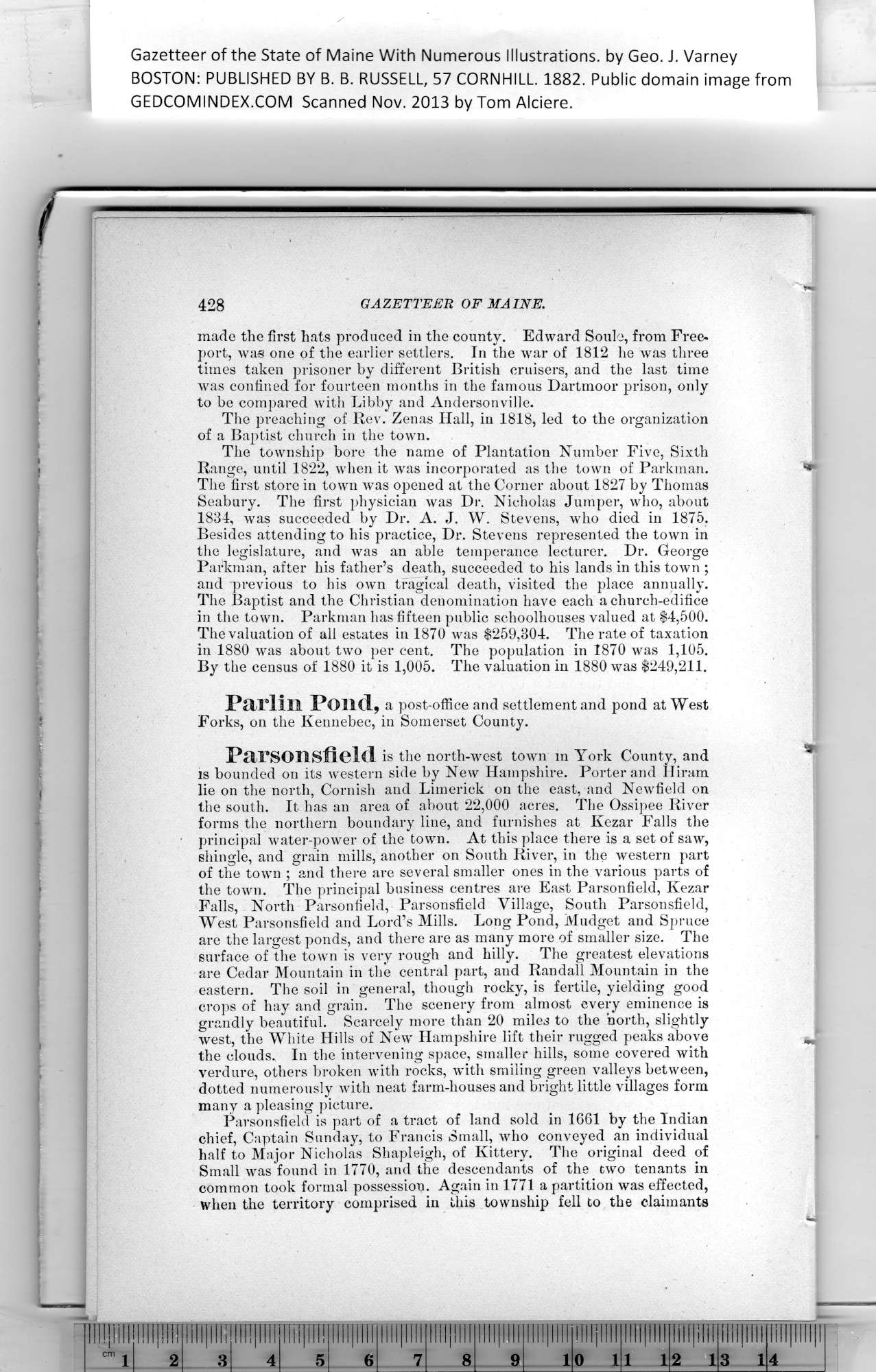|
Gazetteer of the State of Maine With Numerous Illustrations, by Geo. J. Varney
BOSTON: PUBLISHED BY B. B. RUSSELL, 57 CORNHILL. 1882. Public domain image from
428 GAZETTEER OF MAINE.
made the first hats produced in the county. Edward Soule, from Free-
port, was one of the earlier settlers. In the war of 1812 he was three
times taken prisoner by different British cruisers, and the last time
was confined for fourteen months in the famous Dartmoor prison, only
to be compared with Libby and Andersonville.
The preaching of Rev. Zenas Hall, in 1818, led to the organization
of a Baptist church in the town.
The township bore the name of Plantation Number Five, Sixth
Range, until 1822, when it was incorporated as the town of Parkman.
The first store in town was opened at the Corner about 1827 by Thomas
Seabury. The first physician was Dr. Nicholas Jumper, who, about
1834, was succeeded by Dr. A. J. W. Stevens, who died in 1875.
Besides attending to his practice, Dr. Stevens represented the town in
the legislature, and was an able temperance lecturer. Dr. George
Parkman, after his father’s death, succeeded to his lands in this town ;
and previous to his own tragical death, visited the place annually.
The Baptist and the Christian denomination have each a churcb-edifice
in the town. Parkman has fifteen public schoolhouses valued at $4,500.
The valuation of all estates in 1870 was $259,304. The rate of taxation
in 1880 was about two per cent. The population in 1870 was 1,105.
By the census of 1880 it is 1,005. The valuation in 1880 was $249,211.
Parlin Pond, a post-office and settlement and pond at West
Forks, on the Kennebec, in Somerset County.
Parsonsfield is the north-west town in York County, and
is bounded on its western side by New Hampshire. Porter and Hiram
lie on the north, Cornish and Limerick on the east, and Newfield on
the south. It has an area of about 22,000 acres. The Ossipee River
forms the northern boundary line, and furnishes at Kezar Falls tlie
principal water-power of the town. At this place there is a set of saw,
shingle, and grain mills, another on South River, in the western part
of the town ; and there are several smaller ones in the various parts of
the town. The principal business centres are East Parsonfield, Kezar
Falls, North Parsonfield, Parsonsfield Village, South Parsonsfield,
West Parsonsfield and Lord’s Mills. Long Pond, Mudget and Spruce
are the largest ponds, and there are as many more of smaller size. The
surface of the town is very rough and hilly. The greatest elevations
are Cedar Mountain in the central part, and Randall Mountain in the
eastern. The soil in general, though rocky, is fertile, yielding good
crops of hay and grain. The scenery from almost every eminence is
grandly beautiful. Scarcely more than 20 miles to the north, slightly
west, the White Hills of New Hampshire lift their rugged peaks above
the clouds. In the intervening space, smaller hills, some covered with
verdure, others broken with rocks, with smiling green valleys between,
dotted numerously with neat farm-houses and bright little villages form
many a pleasing picture.
Parsonsfield is part of a tract of land sold in 1661 by the Indian
chief, Captain Sunday, to Francis Small, who conveyed an individual
half to Major Nicholas Shapleigh, of Kittery. The original deed of
Small was found in 1770, and the descendants of the two tenants in
common took formal possession. Again in 1771 a partition was effected,
when the territory comprised in this township fell to tbe claimants
PREVIOUS PAGE ... NEXT PAGE
This page was written in HTML using a program written in Python 3.2
|
